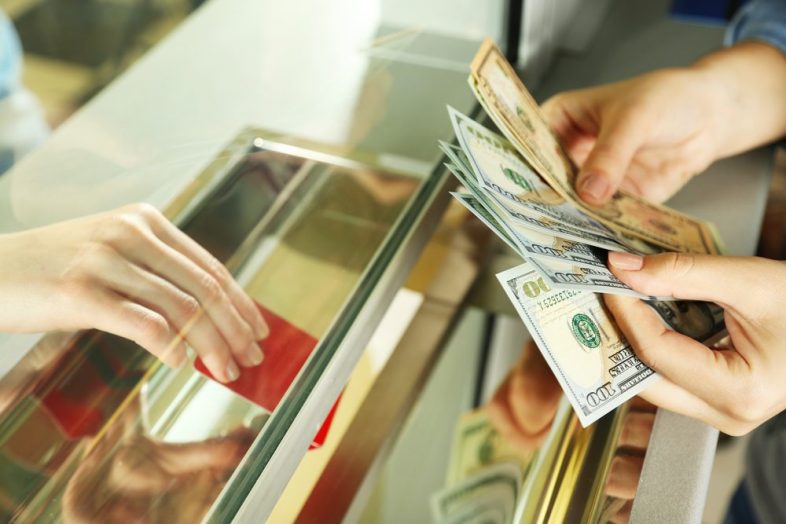What's the Most Amount of Cash You Can Withdraw at Once?

You need a large sum of money from the bank and you're worried that the bank won't give you the amount that you need.
It's an understandable concern for bank customers, especially in a financial emergency.
In fact, your concerns are justified.
Just as there may be rules when it comes to depositing a large amount of funds, the same is true when it comes to making withdrawals.
Withdrawing $10,000, for example, isn’t the same as taking out just $100.
For big-ticket cash withdrawals, there may be limitations on how much you can withdraw at a time. And your bank?
They need to follow special precautions -- one of which involves getting the IRS involved.
Here’s what you'll learn:
- The rules on large cash withdrawals
- How to avoid raising red flags
- Convenience and safety concerns
When You Need to Withdraw Big Money
There may be some instances when a person might want -- or need -- to withdraw a huge amount of money in cash from the bank:
- You want to make a big ticket purchase, like paying cash only for a car without using your credit card and exceeding your credit utilization, which can negatively impact your credit score.
- You’ve that your cash is safer at home.
- You're repaying someone (e.g., you borrowed money earlier).
That doesn’t mean any of those reasons make it a good idea to carry that much cash on you.
It’s dangerous and risky.
Cash is hard to track, easy to lose, and easily stolen.
The Rules on Withdrawing Large Amounts of Cash
When you go to deposit more than $10,000 at a time, your bank, credit union or financial provider is required to fill out a currency transaction report to the Internal Revenue Service.
It’s mainly for security purposes.
The big reason is:
Under the Bank Secrecy Act (BSA), the government wants to make sure you’re not exploiting your bank to fund terrorism or launder money, or that the money you’re depositing isn’t stolen.
Why $10,000 and not $8,000 or $3,000?
The IRS decided that it’s a nice round number that’s large enough to arouse suspicion since deposits of that size are a rarity.
Structuring with smaller amounts
With deposits, some people try to get around filling out IRS Form 8300 by making their $10,000 in smaller increments: $2,000 in one deposit, $5,000 in another, and so on.
However, watch out.
This can trigger an IRS investigation and land you in hot water with the Feds, who call this practice “structuring” (and in some circles, it’s called smurfing).
Structuring is an apparent form of money laundering that assumes you’re trying to circumvent federal rules and regulations by making smaller deposits in the hopes of authorities that the $10,000 cash deposit goes unnoticed.
Crucially:
The same applies to withdrawals.
Deposit or withdrawal, a transaction is a transaction, so a bank withdrawal over $10,000 will involve the same process.
Find the Best Savings Account Rates - Compare Now
Unlock exclusive savings rates and gain access to top-tier banking benefits.
How to Withdraw Cash Without Raising Red Flags
Here's how you should approach it.
The bank might not have that much cash
Firstly, depending on the dollar amount, understand that your bank might not have enough cash in its vault to give you.
The truth is:
Banks don’t often have that much cash on hand, contrary to the image they present.
A $1 million withdrawal may be a bigger sum than your bank branch has on-site.
So, you may be required to wait for a week or two before retrieving your newly liquid currency.
The money needs to be literally shipped in for special withdrawals, and your bank may require you to provide a few days’ notice.
Reasons for withdrawal
You may also need to explain the nature of your withdrawal to the teller or banking rep if it’s over the $10,000 threshold.
While this might seem like an invasion of your privacy, this information is needed for their report to the IRS.
It can look out of the ordinary for someone to withdraw such a significant amount of money, abnormal for a customer who usually deals in small-to-medium-sized transactions.
Is it for business or personal purposes?
The larger the intended cash withdrawal, the more alarming the transaction may seem since cash only sends the signal of “It’s being used for unscrupulous reasons that I don’t want to be traced back to me.”
Note: Banks know that financial scams are out there. Employees may ask for more details to figure out if a customer is about to become a victim of some type of fraud.
Fail to disclose what you plan on doing with the withdrawn funds (especially when it’s cash), and you could be denied the money or reported to authorities for suspicious or potentially fraudulent activity.
You don't have to worry.
All this isn’t meant to discourage or scare you from transacting your own money in your own account.
Remember these tips:
- Cooperate with your bank when planning to make large withdrawals
- Fill out the necessary forms and be prepared with identification (like your driver’s license, passport or other ID), plus account number and details
- Disclose what your bank needs (like what the money will be used for)
- Avoid making smaller withdrawals that add up to $10,000 or more to reduce the risk of structuring
Once you’ve followed all the steps, the money is yours to withdraw.
Safer Options to Consider
The bottom line is:
Huge withdrawals are not only inconvenient but unsafe.
A stack of $10,000 in $100 bills is only a half-inch thick. If you withdrew $100,000, you’d have 10 of them on hand.
Withdraw $1 million, that’s 100 stacks. You’ll look relatively inconspicuous carrying around a suitcase, or even an envelope, full of large bills.
But, that won’t deter a thief from robbing you or breaking into your house knowing you keep cash there.
Plus, anyone with the financial savvy to amass significant funds in the bank should be aware that non-cash methods of investment, deposit, and withdrawal are the smartest -- and safest -- ways to transact money.
Consider some ways to move a large amount of money without transferring cash physically (ATM withdrawals don’t count; they have limits, too):
Use your credit card
If the cash withdrawal was meant to pay for a purchase, better to put it on your credit card and pay the balance off.
That said:
It may mean getting charged interest if you carry a balance from month to month, but it will keep your credit revolving and avoid the risk of carrying a bank’s worth of cash around.
Make sure to check your card’s credit limit first.
Get a cashier’s check
Instead of withdrawing, say, $100,000 in cash, have your bank draft a cashier’s check in your desired amount.
A perfect (and ultimately safer) substitute to carrying around dangerous amounts of cash, the best thing about cashier’s checks is that they work like regular personal checks, but their payment is guaranteed by the bank.
Keep in mind:
There are nominal fees for cashier’s checks (most banks charge about $5), but for large amounts, your bank may waive the fee.
If the check is lost or misplaced, you may also be responsible for purchasing an indemnity bond before you can have a new check issued.
Transfer money electronically
You can use a wide range of methods to transfer money without ever handling the cash yourself.
They include wire transfers, electronic funds transfers, personal payments, and more.
Keeping Your Money Safe
Safety is number one when it comes to making any large transaction -- deposit or withdrawal.
Your bank wants to make sure that bank security isn’t compromised and that it fulfills its obligation to report currency to the IRS.
And, while we can’t advise you against ever withdrawing cash in small or large denominations, taking the steps to stay safe if you’re carrying a larger than usual amount is imperative.
Do your banking during daytime business hours and keep your cash out of reach of potential pickpockets and cash-hungry thieves.
Place your cash inside breast coat pockets or secure it in a bag or purse facing you.
Stay calm and alert from the car to the bank, the bank to the car, and the car to your house, but don’t draw attention to the fact that you might be carrying cash on you.
You may even ask the bank's security personnel to escort you to your car.

